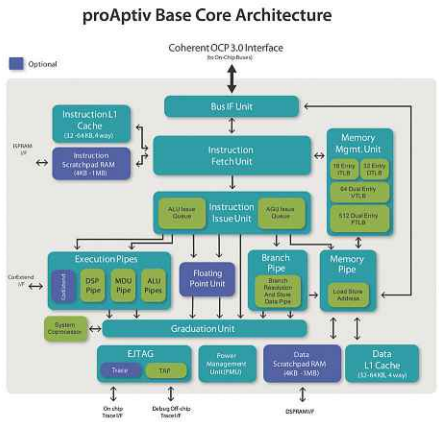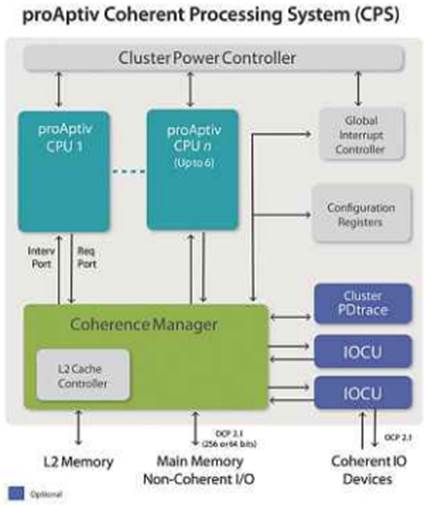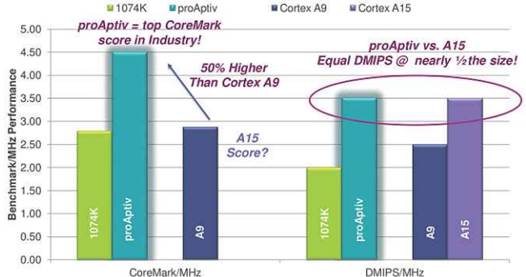Discussions about the CPU
battleground usually focus on Intel and ARM, but MIPS is an exciting newcomer
to the mobile CPU market.
Founded in 1984 by researchers from
Stanford University, MIPS had some successful early years. Its high-speed yet
low-power instruction set was used Silicon Graphics for its workstations, with
the company later buying what was then known as MIPS Computer Systems
Incorporated, and rebranding it as MIPS Technologies in a deal valued at $499
million. The target of the deal was the technology behind the R2000 and R3000
processors. Launched to compete with Intel’s 386 and Motorola’s 68000, the
R2000 was the first readily available reduced instruction set computing (RISC)
processor beating ARM’s first available design by two years.

MIPS’s
proAptiv design includes some neat tricks to keep data flowing
AS a RISC chip, the same benefits of ARM’s
designs such as reduced transistor count compared to CISC and reduced power
draw for similar performance applied to MIPS processors, making them an obvious
choice for the burgeoning handheld computer market. In the early days of
Windows CE palmtops, MIPS and ARM would go head to head, but only one winner
emerged: ARM. When Microsoft moved from Windows CE to Windows Mobile and
Windows Phone, MIPS support was dropped in favor of a dual-architecture ARM
andx86 approach.
Having lost what would later be recognized
as the fight to be at the forefront of the Smartphone revolution, MIPS licked
its wounds and concentrated on other areas. Its high-performance, low-power
architecture found enough traction in networking and high-performance computing
(HPC) markets to keep the company afloat. Now MIPS is back and it intends to
remind ARM that, while it may have won the battle, the war isn’t yet over.

The
proAptiv IP scales up to six cores, each of which is claimed to be 50 per cent
faster than an ARM Cortex-A9
Software support
The first hints that MIPS was looking to
get back into the handheld market came in June 2009, when the company announced
that Google’s Android platform had been ported to the MIP instruction set
architecture. Later that year, MIPS would announce membership of the Open
Handset Alliance, confirming, if there was any doubt, that it was looking at
the mobile market afresh. Under new chief executive Sandeep Vij,
Android-related announcements came thick fast, including the launch of the
Ainol 7in ‘Ice Cream Sandwich’ tablet, the first such device to retail for
under $150. More recently, Karbonn Mobiles was the second company in the world
to announce an Android 4.1 ‘Jelly Bean’ device, based again on a MIPS
processor. As with ARM, MIPS doesn’t make chips, but sells designs to
third-party manufactures. Unlike a manufacturing company such as Intel, which
has to find the cash to produce enough processors to meet demand, MIPS and ARM
can sit back and watch the licensing fees come flooding in – leaving their
various partners holding most of the risk. It’s this risk that’s slowing the
adoption of MIPS over ARM in the mobile industry, with most companies still
opting for the tried-and-tested British option, but a design is coming that
promises to change all that: the MIPS proAptiv core.
Mips proaptiv
Designed for the performance market, the
MIPS proActiv ticks a lot of boxes: available in single, dual, quad or hex-core
flavors, the processor uses a fused triple- dispatch superscalar out-of-order
execution engine, and high-performance floating-point unit, all in a bundle
that takes up less space than the equivalent design from ARM while boasting
equivalent or greater performance.

A
dial-core proAptiv design can fit 1 MB of L2 cache into the same space that an
ARM’s Cortex-A15 needs for the processors alone
Using details released at ARM Tech Con,
MIPS predicts that a dual-core proAptiv chip with 1MB of L2 cache will be just
over half the size of a dual-core Cortex-A15 chip, so you can pack four
proAptiv cores into same space. For devices where every millimetre counts but
high performance is demanded, that’s a powerful argument for a move to MIPS.
Cortex-A15 performance metrics are hard to
find, but are readily available for chips based on ARM’s Cortex-A9 design and
MIPS looks like an early winner. Using the CoreMark benchmark, the ProAptiv
design achieves a score of 4.5 per MHz, some 50 percent hiher than the
Cortex-A9 that’s at the heart of most modern smartphones and tablets.
Considering that the Cortex-A9 design is the basis for high-performance
processors, including Nvidia’s Tegra 3 and Samsung’s Exynos, that’s a pretty
impressive figure.
Just in case you thought MIPS might just be
bad-mouthing the competition, the company is quick to point out that the proApitv
design leaves its own last generation products in the dust too, with a boost of
around 60 per cent compared to its CoreMark per-megahertz results from the
previous MIPS 1074K series.

MIPS
claims that the proAptiv design easily bests the competition, but will OEMs be
convinced?
Under the bonnet
These performance gains come from a wealth
of improvements compared to MIPS’ earlier designs, including some clever tricks
such as the use of instruction bonding to make a single memory system. There’s
also an Enhanced Virtual Addressing [Eva] system for better address space
utilisation, and a sophisticated branch prediction engine that promises fewer
cache misses.
The floating point unit is also
particularly clever. Unlike previous designs, which ran the FPU at a slower
speed than the main processor, the proAptiv design runs the FPU at the same
speed as the CPU. As a result, latency is reduced and the throughput improved,
while the smart use of dedicated schedulers and increased parallelism means
that more instructions can whizz through the system than ever before.
A second-generation coherence manager also
boosts performance, boasting a design that drops latency from around 24 cycles
to 11 and offers around double the system bandwidth over the
previous-generation engine. There’s also a dedicated L2 cache controller within
the coherency manager itself; this required a separate component in previous
designs.
The family of chips envisioned by MIPS
covers a wide spectrum; mobile and tablet versions running between 1GHz and
1.5GHz will feature single, dual or quad-core designs and an integrated
digital-signal processor, while set-top box versions not encumbered by battery
like – will reach 2GHz.
The same architecture will also power
future network devices, with single to hex-core implementations running at
speeds between 1GHz and 2GHz.
The proAptiv design is joined by the
interAptiv and microAptiv families, each cheaper but less powerful than the
last. With the microAptiv, MIPS is even targeting traditional microcontroller
markets held by the likes of Atmel and NXP the latter, funnily enough are now
readily available, meaning that it’s to the company’s customers to make
products based on the chips.
MIPS vs INTEL vs ARM
While Intel and ARM have been fighting,
MIPS has been quietly working on the proAptiv design, and it’s now coming out
of left-field. Suddenly the two giants – one holding a near-monopoly in the
smartphone and tablet market, and the other holding a similar position in the
desktop, laptop and server markets – are fighting a war on three fronts, and
should MIPS’ claims for the benefits of proAptiv sway OEMs, both could lose
serious ground in an increasingly lucrative market.
The coming fight is something of a David vs
two Goliaths epic while Intel has more than 100,000memployees throughout the
world, and ARM has around 2,000, MIPS is a much smaller organization of around
160. Whether that will help MIPS with increased flexibility, or hinder it with
a lack of resources, in competing with two of the biggest names in the chip industry
remains to be seen.